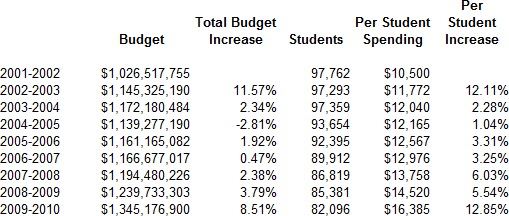
Every year they increase spending. Here is a breakdown of the budget and enrollment by year:
The 07-08 budget was $1.19 billion. The 08-09 budget was $1.24 billion. The 09-10 budget was $1.34 billion.
And it’s worse if you look at spending per student. In 06-07, they spent $12,976 per student. In 07-08 they spent $13,758 per student. In 08-09 they spent $14,520 per student. In 09-10, they spent $16,385 per student.
What do we get for all this spending? A huge number of children who can’t read or do math.
I concede that some costs don’t decrease even when the number of students decreases. So the costs to maintain the buildings and other fixed costs can stay high even when there are fewer students. (Although the people running the district should be doing something to plan for this type of situation!)
But the single biggest reason why it’s become so expensive to run MPS is because of the employee costs. The average salary for an MPS teacher is $56,500, and the average benefits package is $43,505, for total average compensation of $100,005.
Let’s leave the salary issue out of it for a minute. I believe the salaries for MPS teachers are too high, but let’s ignore that for the sake of this discussion, and focus on the benefits. There is simply no way any business can survive with such a large benefits package!
The benefits package costs 77% of the salary. In the real world (read: private industry which is self-sustaining), benefits typically cost about 30% of wages. MPS has a benefits cost nearly 2.6 times higher than the real world.
For this school year, MPS is employing 5,766 teachers. That’s a total cost of $577 million in wages and benefits. If the benefits package cost was reduced to the 30% level that the rest of the country receives, the cost would only be $424 million. Voila! $153 million of instant savings.
And here’s one specific way that MPS can save on benefit costs: Force the employees to choose a more cost-effective health insurance option. In this Journal Sentinel story I’ve linked to, the writer cites the two health insurance options available to employees. They’re both very good plans! One costs $23,820 per family, and the other costs $16,440 per family per year. That’s a difference of $7,380.
MPS employees have zero incentive to choose the cheaper option, even though it is an excellent plan. So why not eliminate the choice and start saving money right away? The big spenders say that shifting everyone to the lower cost plan would cause the per-family cost of that plan to rise because of the way health insurance is priced. I don’t dispute that could happen, but even if it does, there will still be a substantial savings to the district.
So here’s the bottom line… MPS can cry all they want about not having enough money. The fact is that they’re spending too much, and the bulk of that spending is related to teacher costs which can and should be controlled. If the district is unwilling to stand up to the teachers’ union, then everyone needs to shut up. I don’t want to hear the whining about teachers losing their jobs or about class sizes being too large. With the current compensation structure, the only way to have any control over the budget is by reducing the number of teachers.
The teachers have made their choice. It is the teachers alone who are causing budget problems, and they could force their union to solve this problem. They’d still have jobs with generous pay and very good benefits, and there would be money left over for all the things they want to do (but which have to be cut to meet teacher costs).





Interesting article. I am a second year teacher in MPS and earn quite a bit less money than the average teacher. By contract, I will have to move into the city due to the residency rule by the beginning of next year. As difficult as it is to teach in the inner city I would gladly concede benefit costs if they would allow me to live outside of the city limits. As a father of six children, I do not want to uproot them from the school district that my wife and I like them in. I don’t know who fights to keep the residency rule and if pay and benefits are higher to keep people desirous to work and live in the city but I would gladly give the $7400 back to live where I want to.
I believed that the budget repair bill eliminated the residency rule for MPS by the changes made to collective bargaining.
Another MPS teacher who doesn’t want their kids in MPS. No big surprise there.
[…] also via Fraud Files, is a spreadsheet depicting the runaway spending in MPS over the past 10 […]
Last time I looked, the average salary (without benefits) of a person with a masters degree in the private sector was about $80k. Most MPS teachers have a masters degree. Fully loaded, a person in the private sector with masters degree (with benefits) would be at least 100k. If MPS teachers were to renegotiate their compensation package- the number would rightfully start at 100k regardless of how their members choice to spend this 100k (20% salary, 80% benefits or 100% salary and no benefits). MPS teachers total compensation package is neither out of line with the private sector, nor is it out of line with other school districts.
Further- the reality of the matter is–that they have a lock on the market (i.e. they control the supply through smart negotiations, prudent lobbying, legislation of regulations that control their industy). In other professions and industries that use the same strategies —say surgents for example–or auctuaries–or dentists—wages are often much more out of line. You should thank an MPS teacher for being much kinder to your pocket book than your average over paid surgent who in my opinion through simple supply manupulation often earn 500k- 1m a year. The expansion of “medical vacations” to other countries prove this point. There is not doubt that teachers are doing better than many, many people in our country–but than again–so are many other college education professionals that are being hired for their expertise.
Jim, just because you have a Masters does not guarantee you more money. A Master’s degree is something called a choice. It is not required to teach and furthermore no salary requirements need be increased for it.
This is something called supply and demand. And, paying higher salary for teachers with a Masters degree isn’t a high demand – or priority.
I’m trying to tell you that you aren’t entitled to more money no matter how much you think you are.
Jim –
1. Please point me to a source for your claim that people in the private sector with Masters degrees make $80k per year.
2. Please explain how a teaching job, with approximately 190 working days per year, and approximately 6 to 7 hours worked per working day is comparable to a private sector job with 235 working days per year, and approximately 8 to 10 hours worked per working day.
3. Please point me to a source for your claim that most teachers in MPS have Masters degrees.
4. Tell me what a “surgent” is. I’ve never heard of such a job, but since you say it’s so lucrative, it’s something I may want to look into if I know what it is.
[…] The problem with MPS is the employee costs. In March it was reported that the average MPS teacher salary is $56,500, with an average benefits package of $43,505, for total average compensation of $100,005 per teacher. I’m not saying teaching isn’t a tough job or that teachers aren’t important. But I do think the compensation package in MPS is way too high. Remember that this is a 9 month job, so if you annualized the pay and benefits, that equals an annual compensation package of over $133,000. […]
[…] teachers in a less expensive health insurance plan that still gives them full, very generous coverage, but can save the district over $7 million per […]
Jim,
You’re comparing apples and Ferraris with your screed about a Masters Degree in Education v a Masters Degree in, say, Engineering or Finance. A graduate degree in engineering, science, mathematics or a discipline like finance (note: NOT a generic MBA) requires well above average intelligence and drive to earn. A graduate degree in “education” isn’t worth the price of the Cracker Jack box they come out of.
There is a reason that so-called “schools of education” have the lowest SAT scores and the least challenging programs. And it’s the same reason that our children are so ill served in the public education arena. By and large teachers are the lowest collegiate group according to ability and pathetically achieving as a group when you look at the performance of their students.
I would venture to say you are a product of these dolts.
Is there some breakdown for the benefits? I presume this includes the employer portion of social security and medicare, health insurance premiums, and pension contributions. Does it include the actual cost of benefits or the potential cost? (For example, if a teacher COULD use 10 sick leave days but the typical teacher ACTUALLY uses only 2, which number is used?)It is pretty difficult to make any judgments about the benefit level if there is not a breakdown with explanatory materials.
For what is spent per pupil in MPS, it is really sad the lack of results that are achieved. I feel sorry for parents forced to send their kids to these awful schools. Just give the kids the money/some kind of voucher, let them go wherever they want, introduce some accountability standards and get rid of the worst teachers and replace them with better instructors. Everyone knows the schools are failing, but the Teachers Union buys off the elected officials and nothing ever changes. Sad for the kids, sad for the parents, but a good deal for the teachers/MPS administration.
Just wondering – do these budget numbers include the money that is given to voucher schools? Or do these numbers already have the voucher costs removed? Thanks!
MPS does not give money to voucher schools, so there is nothing in this budget related to voucher schools.
[…] fact is right now we’re paying roughly 16, 400 dollars for every student in the Milwaukee Public School program. A voucher for school choice costs only […]
[…] The Chicago school district, like many around the country, is essentially broke because of years of high wages and high benefits costs. You can’t get blood out of a turnip. There is nothing left to give […]